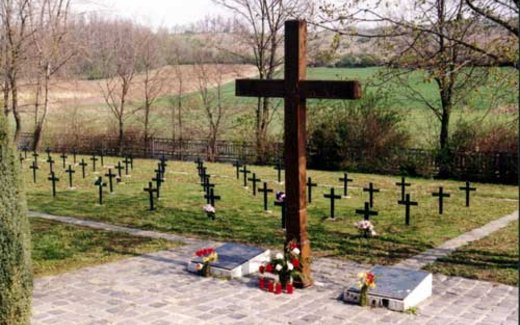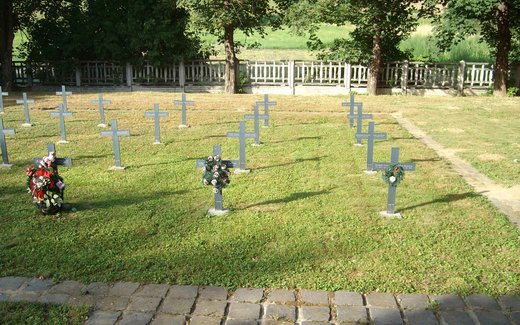The war cemetery is part of the Bajna municipal cemetery. German soldiers who lost their lives in the Second World War are buried there.
Description of the cemetery
Metal crosses with the names and dates of the buried mark the grave locations. The central square of the small war cemetery is marked by a high cross made of oak wood with a commemorative slogan.
Burial
During the Second World War, a number of German soldiers were initially buried in the garden of Bajna Castle. This fell into disrepair during the war, was later used again in socialist Hungary and finally stood empty. The graves in the castle garden were no longer recognizable.
in 1989, the Volksbund Deutsche Kriegsgräberfürsorge e. V. (German War Graves Commission) was given permission to excavate the site. the reburiers were able to recover 153 bodies. They were laid to rest in the municipal cemetery in 1990. There, 20 German soldiers were already resting in individual graves. The extended war cemetery was opened to the public on July 26, 1992.
History
In contrast to other Eastern European countries, Hungary had a positive attitude towards German war graves long before 1989. The first negotiations took place as early as 1963 and Hungary was the only Eastern European country prepared to exchange war grave documents with the Volksbund.
The planning of military cemeteries began in 1979 and the first sites were built in 1984. A war graves agreement has existed with Hungary since 1993 - the legal basis for the Volksbund's work.
The war graves there are still marked with individual crosses today. The Volksbund's point of contact is the Military History Institute and Museum in Budapest, which is responsible both for Hungarian war graves abroad and for war graves of other nations in Hungary.
Special feature
The castle in whose garden the War Graves Commission found the soldiers' graves was built in 1720 as a hunting residence. The Counts of Sándor made it their manor house in the late 18th century. In the mid-19th century, Móric Sándor had it transformed into a lavish palace for his wife, Princess Leontine Metternich. As part of a national program for the preservation of castles and palaces in Hungary, Sándor-Metternich Castle was restored from 2016.


